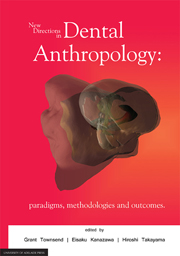Book contents
- Frontmatter
- Foreword
- Contents
- 1 Modelling the complexity of the dentition
- 2 New approaches to dental anthropology based on the study of twins
- 3 Genes for teeth — drawing inference from family data
- 4 Do feeding practices, gestation length, and birth weight affect the timing of emergence of the first primary tooth?
- 5 Sexual dimorphism in the primary and permanent dentitions of twins: an approach to clarifying the role of hormonal factors
- 6 Dental crown and arch size in Europeans and Australian Aboriginals
- 7 Sex determination from maxillary and mandibular canines of the Filipino population
- 8 Non-metric dental characteristics in Papua New Guinea Highlanders and their association with molar reduction
- 9 The Main Occluding Area between opposing teeth during chewing: a comparison between Australians and Japanese
- 10 “Mineral Maintenance” of dental structures in caries and erosive tooth wear: an holistic model
- 11 Emerging techniques for the analysis of tooth wear
7 - Sex determination from maxillary and mandibular canines of the Filipino population
Published online by Cambridge University Press: 05 May 2013
- Frontmatter
- Foreword
- Contents
- 1 Modelling the complexity of the dentition
- 2 New approaches to dental anthropology based on the study of twins
- 3 Genes for teeth — drawing inference from family data
- 4 Do feeding practices, gestation length, and birth weight affect the timing of emergence of the first primary tooth?
- 5 Sexual dimorphism in the primary and permanent dentitions of twins: an approach to clarifying the role of hormonal factors
- 6 Dental crown and arch size in Europeans and Australian Aboriginals
- 7 Sex determination from maxillary and mandibular canines of the Filipino population
- 8 Non-metric dental characteristics in Papua New Guinea Highlanders and their association with molar reduction
- 9 The Main Occluding Area between opposing teeth during chewing: a comparison between Australians and Japanese
- 10 “Mineral Maintenance” of dental structures in caries and erosive tooth wear: an holistic model
- 11 Emerging techniques for the analysis of tooth wear
Summary
ABSTRACT
The aim of this study was to derive Filipino-specific formulae that can be used as supplementary tools for sex discrimination, especially in forensic cases. Three dimensions — clinical crown height (CCH), maximum mesiodistal breadth (MMD) and maximum buccolingual width (MBL) — of the maxillary and mandibular canines were measured in 100 male and 100 female Filipino participants. CCH emerged as the most significant variable in determining sex in maxillary canines while CCH and MMD were both statistically significant in mandibular canine sex determination. Tree models were derived and 39 data sets were analysed as a test of accuracy. The accuracy ratings for the maxillary and mandibular trees were 56.41% and 74.36%, respectively. The mandibular tree is recommended for use in cases with incomplete or fragmented human remains when no other skeletal elements yielding higher accuracy estimates are available. The results of this study contradict the previous claim of no significant dimorphism in the dentition of the Filipino population.
INTRODUCTION
Sexual dimorphism has always been an interesting issue in primate and human evolution and the canine teeth are some of the most studied and debated elements. Researchers (Almquist, 1974; Crook, 1972; Clutton-Brock and Harvey, 1977; Greenfield, 1992; Guatelli-Steinberg, 2009; Harvey et al., 1978; Kay et al., 1988; Leutenegger, 1982; Leutenegger and Cheverud, 1985; Leutenegger and Kelly, 1977; Lucas et al., 1986; Oxnard et al., 1985; Plavcan, 2001, 2004; Plavcan and Ruff, 2008; Plavcan and van Schaik, 1992, 1994; Royer et al., 2009) have already shown that canine teeth exhibit sexual dimorphism and are one of the most obvious secondary sex differences among non-human primates.
- Type
- Chapter
- Information
- New Directions in Dental AnthropologyParadigms, Methodologies and Outcomes, pp. 81 - 91Publisher: The University of Adelaide PressPrint publication year: 2012
- 2
- Cited by



